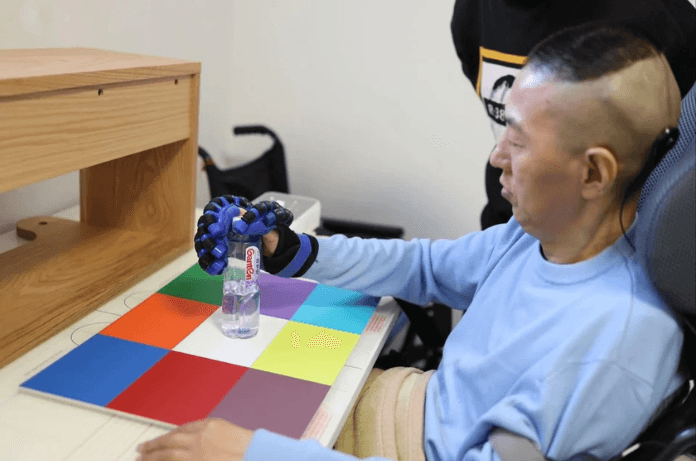Imagine a world where people could move objects just by thinking about them. A world where machines and the human brain work seamlessly together. Sounds like science fiction, right? But this futuristic concept is closer to reality than you might think. On one side Elon Musk is building the Neuralink with almost the same concept and on the other side China is challenging America. In China, groundbreaking technology known as Neural Electronic Opportunity (NEO) is revolutionizing the way the brain interacts with electronic devices. This innovation is on the verge of transforming lives, offering new hope to those with mobility impairments.
Next year, Chinese researchers are set to launch an extensive clinical trial to explore this cutting-edge technology further. The excitement isn’t just in the potential of the technology, but also in how quickly it’s advancing. Imagine regaining the ability to pick up a cup or open a bottle cap after years of paralysis. This is the thrilling journey of brain-computer interface (BCI) technology that merges human thought with machines.
NEO: The Semi-Invasive Brain-Computer Interface Changing Lives
Developed collaboratively by Neuracle Technology and a team led by Hong Bo from Tsinghua University’s Biomedical Engineering. NEO is making waves in the field of BCI. Unlike Elon Musk’s Neuralink, which embeds chips directly into the brain, NEO uses a semi-invasive approach. Electrodes are strategically placed outside the brain cortex, avoiding direct contact with brain tissue. This design reduces risks while maintaining high performance.
In November, a breakthrough procedure took place in Shanghai. Surgeons implanted a coin-sized NEO device into the skull of a 38-year-old patient who had suffered a spinal cord injury in a car accident four years ago. Since then, the patient has lost the ability to stand and use his hands. Thanks to NEO, this patient can now perform tasks like lifting a water cup, unscrewing a bottle cap, and other daily tasks involving hand functions, all through brain signals.
The Cutting Edge Technology Behind NEO
The success of NEO lies in its sophisticated design. During the implantation surgery, the device was inserted into the patient’s skull to gather neural signals from the sensory and motor regions of the brain. Power and communication were managed by an external magnetic coil connected through the scalp. This coil transmits signals, supplies power, and updates algorithms seamlessly.
One of the key advantages of NEO is its ability to rapidly locate specific brain functions. In the November procedure, surgeons used an “online brain function localization system” to pinpoint the hand motor and sensory areas precisely. This efficiency reduced the surgery time to just 1 hour and 40 minutes.
Mao Ying, head of the National Centre for Neurological Disorders and director at Huashan Hospital, praised the outcomes, stating, “The results are even better than we expected.” The patient’s recovery was smooth, and the improvements in mobility were dramatic.
A New Era for Patients with Spinal Cord Injuries
For individuals with spinal cord injuries, regaining independence can feel like an impossible dream. NEO is helping turn this dream into reality. Using a prosthetic glove, the Shanghai patient can control brain signals to complete everyday tasks. This isn’t just a medical breakthrough; it’s a pathway to restore dignity and freedom.
The success story in Shanghai builds on two earlier implantations conducted in Beijing last year. Those procedures enabled paralyzed patients to move a computer cursor and drink water independently. These results demonstrate the versatility and potential of NEO to assist people with varying degrees of paralysis.
The Road Ahead: Large-Scale Clinical Trials
The upcoming clinical trial marks a significant milestone for NEO. Hong Bo announced plans for at least 30 implantations across China starting next year. The trials aim to further validate NEO’s safety and effectiveness, paving the way for widespread clinical use. This announcement came during the BCI Society and Chen Institute Joint BCI Meeting held in Shanghai.
In August, NEO achieved another major breakthrough by becoming the first BCI product to enter China’s “green channel” for special approval of innovative medical devices. This expedited pathway ensures that life-changing technologies reach patients faster. If everything proceeds as planned, NEO could be available for clinical use by 2027.
BCI: A Convergence of Cutting-Edge Technologies
Brain-computer interface technology isn’t just about neural signals and it represents a convergence of artificial intelligence, integrated circuits, and biomedical engineering. This fusion of fields creates endless possibilities for innovation.
Tao Hu, deputy director of the Shanghai Institute of Microsystems and Information Technology at the Chinese Academy of Sciences, remarked, “As an emerging industry, it still requires concentrated investment of various resources.” Indeed, while universities drive much of the research, the path from laboratory to market needs substantial investment and collaboration.
NEO vs. Neuralink: A Different Approach
Comparisons between NEO and Elon Musk’s Neuralink are inevitable. While both technologies aim to connect the brain with machines, their approaches differ significantly. Neuralink implants chips directly into the brain tissue, offering potentially high precision but with greater risks. In contrast, NEO’s semi-invasive method places electrodes outside the brain cortex, minimizing invasiveness while still delivering impressive results. This difference could make NEO more appealing for broader clinical applications, particularly where safety and long-term viability are paramount.
The Future is Here, and It’s Electric
Brain-computer interface technology like NEO is transforming science fiction into reality. For patients with spinal cord injuries, it offers a new lease on life. As China prepares for large-scale clinical trials, the world watches with anticipation. Will NEO become the standard for BCI technology, providing millions with renewed mobility and independence?
The journey is far from over, but the progress so far is nothing short of remarkable. With rapid advancements and strategic investments, the dream of seamless brain-machine integration is closer than ever. And it sounds amazing!

